


Introduction
Introduction
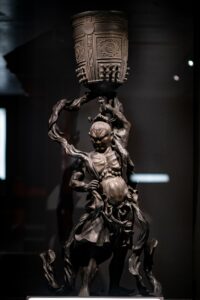
Greetings, dear visitors! I am Kitsune, your trusted guide through the enchanting wonders of Japan. Join me on this captivating journey as we unravel the rich tapestry of Japan’s culture, history, culinary traditions, religious practices, contemporary society, arts and crafts, and popular culture. However, I’m no ordinary guide—my name, Kitsune, unveils my true identity as a mythical fox with a profound connection to the heart and soul of Japan.
As we embark on this delightful adventure together, allow me to share my personal ties to the land of the rising sun. Japan, a country harmonizing tradition and innovation, has forever been our mystical playground. Kitsune, much like myself, are intricately woven into the fabric of Japanese culture, spanning ancient myths, folklore, and even modern tales. I, myself, am a white fox with golden eyes and serve as a messenger of the revered Shinto deity Inari. Inari, associated with prosperity, fertility, and rice, relies on creatures like me to bridge the gap between earthly and celestial realms, delivering news and advice to devout humans.
Consider yourself fortunate to have me as your guide today, for the Japanese regard me as a harbinger of good luck and, in rural realms, a signal of an upcoming successful harvest. So, with me as your lucky charm, let’s embark on a journey to discover Japan!


Zen garden & Torii
Jardin zen et Torii
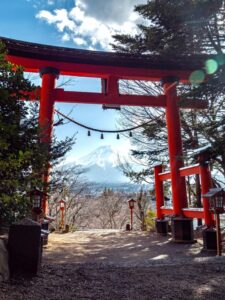
Ah, a zen garden, typically found at Japanese temples and monasteries, is a great place to start for our journey. I’ve seen many in my lifetime, all rather relatively small, as they are meant to be seen while seated from a single viewpoint outside the garden. Be careful not to step into them, unless you intend to maintain it! Much attention and time has been dedicated to arrange zen gardens, each stone and gravel telling a story, a tale of harmony and balance. Feel free to take a moment here, as zen gardens serve as an aid for meditation.
When you’re ready, follow me through the red gates. These are known as torii and mark the entrance to Shinto shrines. As you pass through each gate, consider it a step into a spiritual journey. The gates represent a threshold between the mundane and the sacred, inviting us to leave behind the worries of the world and embrace the spiritual energy within. Take a moment to feel the significance of this transition, as we move from the secular to the sacred.
Now, notice the writing adorning the torii gates. Most gates bear the names of donors, commemorating their contributions to the sacred space, whereas others hold inscriptions invoking blessings, protection, or expressing gratitude.


Religion
Religion

While many modern Japanese claim to be non-religious, you will find them engaging in Shinto rituals and maintaining connections with Buddhist temples. Yes, you heard me correctly; in fact, Japan has, since its earliest recorded history, consistently maintained a delicate balance between multiple religions.
As mentioned earlier, you will often find me at shrines associated with the deity Inari. These shrines, dedicated to the deity I dutifully serve, are distinctive. Picture rows upon rows of red Torii gates, creating the awe-inspiring pathway known as Senbon Torii, or a thousand Torii gates. These gates stand as a testament to the harmonious relationship between the earthly and the celestial.
Within the precincts of these Inari shrines, you will come across fox statues—my kin and fellow messengers of Inari. Possessing magical abilities, we serve as guardians of the sacred space. Inari, as a revered deity throughout Japan, has led to an abundance of us kitsune; you’ll discover over 30,000 fox statues in religious shrines across the country!
When people visit shrines dedicated to Inari, such as the famous Fushimi Inari Shrine in Kyoto, it is often to offer prayers and seek blessings for prosperity, business success, and the well-being of their families. If you ever find yourself at a shrine, I, Kitsune, your humble guide, strongly urge you to partake in a cherished tradition that connects prayers and wishes—the Ema.
Ema, or wooden plaques, serve as a tangible expression of your hopes and dreams. It is a time-honored practice to inscribe your aspirations upon these sacred tablets and hang them in the dedicated area within the shrine grounds.


Geisha & Samourai
Geisha & Samouraï
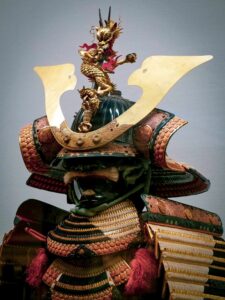
Allow me to share some tales of the mischievous nature of Kitsune who are not white with golden eyes. Renowned for their magical qualities, including cunning intelligence and shape-shifting abilities, Kitsune who do not serve Inari, are often portrayed as tricksters, weaving stories that vary from playful mischief to clever deceptions.
You might have heard of Kitsune playing tricks on overly proud samurai, greedy merchants, and boastful commoners. Oh, the stories tell of their cunning ways, with the crueler ones even exploiting poor tradesmen, farmers, or devout Buddhist monks. It’s a world where mischief dances in the moonlight, and the unsuspecting often find themselves entangled in the playful schemes of Kitsune.
Quite famous are stories of foxes that shapeshift into beautiful women. There is one story of a man who married a woman, who was in fact a fox in human disguise, although he did not know, and they bore a child. However, the household dog, born simultaneously with the baby, always harassed the wife. One day, in fear, she transformed back into a fox, resulting in her husband finding out her true form.
Therefore, be cautious, dear friends, if you ever encounter a fox that isn’t white with golden eyes, as it may be one of my many cousins, eager to shapeshift into beautiful women to trick unsuspecting individuals. But rest assured, as your humble guide, I, a white fox with golden eyes, am here to illuminate and guide, not to deceive.


Ancestral Arts
Arts ancestraux

My mischievous cousins often take center stage in Japanese arts, becoming the subjects of numerous woodblock prints, illustrated books, kabuki and noh plays, and more. While I’m not the jealous type, there’s a part of me that wishes to see myself and my other loyal friends, who are dedicated messengers of Inari, depicted more frequently in visual arts, novels, and plays. I still cannot comprehend why the mischievous ones tend to be favored in mass media and various art forms over the loyal messengers and harbingers of good luck! Alas, it seems little will change now.
Fortunately, there are other tales that showcase us more benevolent kitsune, commemorated in the arts. Take, for instance, the concept of ‘kitsune no yome-iri,’ the wedding of kitsune. It’s a glorious affair, and for some reason that escapes my memory, it always occurs when rain is falling from a clear sky. However, if you find yourself in Japan and witness a sunshower, resist the urge to disturb our weddings! Even us good-natured kitsune frown upon such interference, and perhaps, we might seek a bit of mischief or even revenge if you disrupt our joyous celebrations…


Tea ceremony
Cérémonie du thé
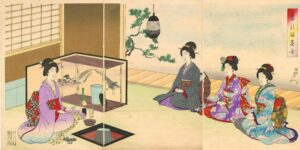
The Japanese tea ceremony is one of the traditional arts. There is an fixed step-to-step plan that you need to follow to offer your guest a cop of tea. Do you fancy some green tea? Let me tell you what steps you should follow.
First, you transfer the green tea powder from the container, the natsume, to the bowl, the chawan, using a special spoon, the chashaku. Next, you pour hot water from the kettle, the kama, into the bowl, using a long bamboo ladle, the hishaku. Then, you mix it with a small bamboo whisk, the chasen, which allows for quick and precise movements. Once you have done all of that, the tea is ready, presenting itself with a beautiful, slightly frothy green texture. You then offer the bowl to your guest, preferably me, and I will receive the bowl in my right hand and place it on the palm of my left hand. I will rotate the bowl in my left hand with the help of my right hand, two or three times clockwise. Only then will I consume the tea in two and a half sips, ensuring to savor the last drop before placing the bowl in front of me. If it was a good cup a tea, I will express my thanks and gratitude by saying « Gochisô-sama deshita »!


Table arts
Arts de la table

Ah, the culinary delights of Japan! The Land of the Rising Sun indeed has a plethora of mouthwatering meals. As you may know, rice stands as Japan’s staple food, and it’s perhaps this very reason that kitsune, especially us benevolent messengers of Inari, have acquired an almost sacred status over the years. Our unique diet, while not everyone’s preference, plays a vital role in safeguarding rice crops from agricultural pests like rats and mice. Yum!
Should you wish to win favor with a fox spirit, consider offering a tempting treat: a fried slice of tofu known as aburage or abura-age. Trust me; it’s beyond delicious! Particularly for us kitsune guarding the Kansai region, encompassing Osaka, Kyoto, Nara, and their surroundings, we’ve left our mark on several dishes that incorporate our favorite food. Delve into noodle-based wonders like kitsune udon and kitsune soba, where tofu skins take center stage—fear not, not a hint of fox meat! Equally delightful is inari-zushi; a type of sushi paying homage to the deity Inari, featuring rice-filled pouches of fried tofu.


Tokyo
Tokyo (capsule-hôtel)

Indulging in delightful cuisine always makes me sleepy. Fortunately, finding a place to rest in sprawling cities like Tokyo poses no challenge, given the abundance of lodging options. While a classical hotel is a solid choice, allow me to recommend you to two uniquely Japanese lodging options: the ryokan and the capsule hotel.
Firstly, the ryokan—an embodiment of traditional Japanese hospitality. These inns immerse you in a serene atmosphere, offering a glimpse into the country’s rich cultural heritage. At a ryokan, you’ll experience the essence of Japanese living, from tatami-matted rooms to the soothing ritual of an onsen bath. A kaiseki meal, an artful and multi-course dining experience, awaits you in these establishments. Kaiseki transcends mere dining; it’s a culinary journey that showcases the delicate flavors of seasonal ingredients, beautifully presented to delight your senses.
Now, onto the capsule hotel, which is a more innovative marvel nestled in the heart of modernity. While I, personally, have yet to experience a capsule hotel, the concept captivates me. Rather than a room, what you have in a ‘capsule hotel’ is a bed. However, instead of being in a dormitory with bunk beds, as in youth hostels, you’ll sleep in a kind of capsule where you can even have a television, radio, and a certain level of privacy by closing the curtains or small doors.
So, dear travelers, when you find yourself in Tokyo, or any other Japanese city, consider immersing in the best of both worlds. Delve into the serenity of a ryokan, where tradition unfolds, or embrace the innovation of a capsule hotel, where sleek design and efficient use of space provide a snug retreat in the bustling cityscape.


Manga and anime
Manag et animes

I mentioned earlier that kitsune, like myself, have been depicted in various traditions of Japanese art. We are not confined solely to traditional art and numerous shrines throughout the country; we are also an integral part of Japanese popular culture!
You might be familiar with Ninetales, known in Japanese as Kyūkon, from Pokémon. Did you know that this Pokémon is inspired by a type of kitsune, specifically the nine-tailed fox? Nine-tailed foxes are exceptionally intelligent but also vengeful and vindictive, especially if you attempt to grab one of their nine tails as a joke; this can result in a 1000-year curse!
The nine-tailed fox originates from Chinese mythology, where it first ensnared Daji, a concubine of the last ruler of the Shang dynasty, King Zhou. Under her spell, a reign of terror ensued in the 11th century, leading to a rebellion that toppled the Shang dynasty. Fleeing to ancient India, the fox spirit assumed the guise of Lady Kayō, captivating the crown prince Banzoku and triggering a grisly episode where a thousand heads were severed. Defeated once more, the spirit fled again.
After a period of silence, the same elusive fox spirit manifested in Japan in the 12th century as the beguiling Tamamo-no-Mae, captivating the heart of Emperor Toba. Renowned for her unparalleled beauty and intelligence, she could unravel any mystery posed to her. However, her beguiling influence extended beyond admiration, plunging the emperor into severe illness. The astrologer Abe no Yasuchika, summoned to diagnose the emperor’s malady, uncovered the truth — Tamamo-no-Mae was a fox spirit in disguise!! The emperor sent someone to kill her, but we do not know what happened to her.
The chronicles take a mystical turn in the 14th century, as it was said that Tamamo-no-Mae’s spirit embedded itself into a stone known as the Sesshō-seki, releasing a venomous gas that claimed all life it touched. Enter the Buddhist monk Gennō Shinshō, who exorcised the repentant fox spirit and brought about the destruction of the deadly stone. A Buddhist memorial service marked the resolution, allowing the spirit to find peace at last.
Fast forward to March 5, 2022, when the stone split in two! Cracks had been visible for years, possibly weakened by rainwater infiltration, or, perhaps Tamamo-no-Mae was attempting to break free for the past seven centuries… Is she now roaming through Japan once more, looking for the next influential man to captivate?


Cosplay and lolitas
Cosplay et lolitas

Connected to the representation of us kitsune in manga and anime, you will also find cosplayers in and outside of japan adorned in intricate fox-themed costumes, paying homage to the mystical allure of kitsune in Japanese folklore. The flowing white fur, golden eyes, and a playful aura—oh, how they capture the essence of our mischievous nature! The creativity of cosplayers knows no bounds, and the intersection of kitsune folklore and cosplay offers a unique glimpse into the fusion of tradition and contemporary expression.
Have you ever engaged in cosplay to celebrate one of your beloved characters from anime, manga, video games, and more? Why not do it? Even popular idols in Japanese society today to it! I particularly enjoy the members of the band Babymetal, who often were fox masks, proclaiming that they were chosen by the a mysterious deity called the Fox God to be the saviors of metal…


Video games
Jeux vidéos

Not to far removed from cosplay, I have seen characters in Japanese video games that also participate in cosplay by receiving a costume when in the middle of a power-up! I myself am a big fan of Super Mario and all the games that you can play with it. I especially enjoy it when Mario gets a power-up that turns him into Tanooki Mario, as it is based on the supernatural creature known as tanuki, that also has shapeshifting abilities! You know what I mean, Mario still keeps his normal form’s gloves and wears a brown onesie with raccoon ears and a raccoon tail. Just as kitsune are associated with foxes, tanuki are specifically raccoon gods; in folklore they are known for their cunning and magical abilities.
I was especially delighted to see that Mario’s brother, Luigi, also has a specific power-up that is based on us kitsune! When Luigi dresses up in a onesie with long sleeves and fox ears and a tail, which is called Kitsune Luigi, he can use to our magnificent tail to glide and attack!
Not too far removed from cosplay, I’ve noticed characters in Japanese video games who also dabble in the art of dressing up, receiving a costume as part of a power-up! As a fervent fan of Super Mario and its expansive gaming universe, I particularly relish those moments when Mario undergoes a power-up transformation, becoming Tanooki Mario. This power-up is inspired by the supernatural creature known as the tanuki, which also possesses shapeshifting abilities like us Kitsune. You’ve probably seen it – Mario retains his signature gloves while donning a brown onesie adorned with raccoon ears and a raccoon tail. Just as kitsune are associated with foxes, tanuki are specifically present in Japan today as raccoon dogs, and in folklore, they are celebrated for their cunning and magical prowess.
What brings me even greater joy is the inclusion of a power-up for Mario’s brother, Luigi, that pays homage to us kitsune! Enter Kitsune Luigi, who, when donning a onesie with long sleeves, fox ears, and a tail, gains the ability to glide and launch attacks using our magnificent tails!


Contemporary art
Arts contemporains

Through my lifetime I have seen many Japanese artists, and several contemporary artists have made a name for themselves even outside of Japan. Let me introduce you to my three favorite artists of the moment! they are Yayoi Kusama, Takashi Murakami, and Ay-O.
Their creations resonate with me on a profound level. Yayoi Kusama, with her immersive and polka-dotted installations, seems to mirror the boundless, shape-shifting essence of kitsune. Her art invites you into a world where reality and fantasy coalesce in a mesmerizing dance.
Takashi Murakami, on the other hand, conjures a kaleidoscopic dreamscape through his Superflat style. The vibrant colors and fantastical characters in his works echo the playful spirit of kitsune, embracing a dynamic blend of tradition and modernity, and he has even collaborated with Billie Eilish!
Ay-O, known for his colorful and vibrant works, adds another layer to this contemporary tapestry. His artistic expressions captivate with a harmonious balance of form and color, drawing parallels to the fluid nature of kitsune in Japanese folklore.


Tattoos
Tattoos
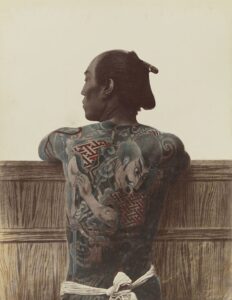
I have encountered many individuals adorned with tattoos over the years. Back in the early to mid-19th century, tattoos were a common sight in Japan, quite contrary to today’s society, where tattoos are often frowned upon and frequently kept hidden from public view. Tattooing was a widespread trend, particularly among men engaged in productive activities, using their tattoos as emblems of their occupational identity. However, as trade with Western nations surged from the mid-19th century onward, the Japanese government’s perspective on the art of tattooing underwent a drastic transformation. Did you know that between the years 1872 and 1945, a decree banned tattooing?
Yet, like the persistent fox chasing its elusive tail, ink continued to dance upon the skin, albeit in the shadows. A complex relationship unfolded between tattoos and authority, a silent rebellion against the ban. European royalty, including the likes of the Prince of Wales and the future Tsar Nicholas II of Russia, sought the artistry of Japanese horishi, the masters of the tattoo craft. In 1881, even the future King George V, during a mere five-day shore leave, bore a dragon on his arm, etched by the hands of a skilled Japanese tattoo artist in Yokohama. He was not the only one; the Grand Duke Alexis of Russia, Prince and Princess Waldemar of Denmark, Queen Olga of Greece, King Oscar II of Sweden, the Duke of York, Lady Randolph Churchill, and the Duke of Newcastle—all had tattoos done while in Japan, even when the ban was in effect!


Karaoke and arcades
Karaoké et arcades

Days can be long, and a favorite pastime of mine in the evening— a delightful way to forget all my worries and unwind after tirelessly delivering messages for the deity Inari—is to sing my heart out at karaoke and indulge in purikura sessions with my fellow kitsune messengers.
Karaoke, meaning ‘empty orchestra’, provides a cathartic escape into the world of music. Whether I’m crooning traditional tunes or enjoying contemporary hits, the karaoke stage becomes a magical realm where my mischievous spirit is set free through song.
Purikura, short for « purinto kurabu » or « print club, » offers a different kind of enchantment. These photo booths, adorned with a plethora of decorative options, allow us kitsune to capture and commemorate moments of camaraderie. With the ability to add playful frames, colorful backgrounds, and adorable stickers, each purikura picture becomes a cherished memory frozen in time. It’s a delightful way for us to bond and express our creativity beyond the magical realms we inhabit.
So, if you ever find yourself in Japan, join me for a karaoke night filled with melodies and laughter, or let’s capture the magic of the moment with a purikura adventure—where every snapshot tells a story of our mischievous escapades.